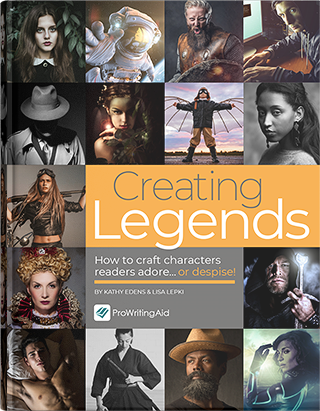
A great main character, a rocking concept, and genre staples will entice readers to your story, but without sustaining tension, you will lose readers’ attention.
Your writing goal is to get readers to care about the story’s outcome. When a reader thinks “I want to see how this turns out,” they're experiencing dramatic tension. This applies to every genre. Fantasy, thriller, romance, mystery, science fiction: they all need story-long dramatic tension to keep readers turning pages.
Every story has two levels of dramatic tension – external and internal. When you understand each type, you can weave them into your story to keep readers hooked.
External Tension
When you generate your story’s tension by its main dramatic conflict, usually, that conflict is external. It’s what readers call “the story.”
The basis for the conflict is based on primary story elements.
- The protagonist – the character whose story it is
- Their problem – the problem producing predicament forced on the protagonist
- Their goal – what the protagonist thinks is the solution to the problem
- The opposition – forces preventing the solution
- Their motivation – what will be gained or lost from winning or not achieving the solution
When readers abandon a book, it’s often because the outcome is predictable or the protagonist hasn’t earned their involvement. If the reader doesn’t care about the protagonist and their struggles, they’ll have a hard time caring about the outcome.
Careful use of the external conflict elements will pose dramatic questions for the reader, eliciting emotional anticipation regarding the story’s ending. Their anticipation can be emotional or intellectual, but the story must elicit questions about the outcome.
Emotional dramatic questions stimulate emotional reactions. Reader empathy, sympathy, or identification with the protagonist is essential for building emotional tension. And, something meaningful must be at stake. These questions are usually very simple, e.g. Will Ishmael survive Captain Ahab’s obsessive search for the white whale? Will Count Rostov escape house arrest at the Metropol Hotel?
Intellectual dramatic questions aim for rationale and logic. They are based on how, who, what, and why. Thrillers, mysteries, and detective stories ask these questions in a puzzle the protagonist must solve. These questions also work in biographies, historical fiction, and true stories where the reader often knows how the story problem is solved but wants to know why, e.g. Why did Frank Sheehan kill Jimmy Hoffa? How did a San Francisco reporter track the Zodiac? How did Jason Bourne lose his memory, and what forces keep him from discovering the truth?

Internal Tension
Characters may evolve toward a higher or lower nature, for better or worse, greatly, moderately, or not at all. What matters is that the character’s inner conflict, or lack of it, facilitates the story. If the protagonist has inner conflict, it needs to create tension in the story. Like any story element, it must move the story forward.
Internal tension varies by character, but to make it work in a story, it is usually based on four internal conflict elements.
- The protagonist’s internal issue – the dilemma or flawed state that holds them back
- Their inner goal – the ideal state where the story pushes them
- The opposition – the forces that prevent the ideal state, often the protagonist’s own fear or misunderstanding
- The stakes – the positive or negative outcome of resolving or not resolving their internal predicament
Use the elements to create a tug-of-war within the protagonist – the struggle between the flawed state which feels safe and the risk of attaining the ideal state. This struggle can be either conscious or unconscious.
In a conscious struggle, the protagonist is painfully aware of flaws but makes bad choices to continue in the current state, e.g. Will Harry Høle give up alcohol to save his career and his love life?
The protagonist is barely aware of unconscious dramatic questions. They don’t see they are constrained by limited understanding, a negative quality, or the trauma of an emotional wound.
Inner tension doesn’t require a particular type of story ending – heroic or tragic. The tension comes from the protagonist’s inner struggle as the story progresses. A protagonist with inner tension is a powerful method for creating reader sympathy for caring about the external conflict of the story.

Tension Escalation
Build both external and internal tension with escalating stakes. Each small struggle poses a question in the reader’s mind. And, as the stakes raise – the villain outfoxes the protagonist, the love of his life leaves because of the alcohol problem – the reader cares more about the story outcome.
Give the protagonist more to lose with each conflict to stoke reader engagement until the final resolution. Each challenge to a conflict, external or internal, keeps the reader wondering. Raising questions about each conflict creates more tension about the final outcome. Will the protagonist get his own back? Will his lover return?
Writers often struggle with building tension by trying to force an external conflict or laboring an inner conflict. What dire predicament can I dream up next? How can I show the protagonist’s struggle with relationships? Turn it around by posing a question for the reader. You’ll have better success creating conflict if you think about how you can raise a question in the reader’s mind.
Balance dramatic questions for external and internal tension. After a high-tension external scene, don’t let up. Give your protagonist another conflict with internal demons. Tension of any kind raises questions for your reader. Make them wonder, and don't give them all the answers right away.
Start with Your Character
As you work on your main character’s background, think of how each character trait can cause problems for your protagonist. How your character thinks may blind them to ways out of trouble. When a situation approaches the edge of their moral compass, give them an almost impossible decision. Examine their personality for how they respond to anger or crisis.
When you list your character’s likes and dislikes, think of how you can augment those traits when faced with internal conflict.
The more you understand your protagonist as a human being with strengths and frailties, the better you can create tension with each story conflict. How your protagonist resolves external and internal conflicts will be based on their overall design. The design created by you. The way you construct your character will have an impact on how the tensions in your story play out.
Work with Uncertainty
Create dramatic questions for the reader with external and internal predicaments. Work to create uncertain, undecided, or mysterious situations that raise reader questions. Aim for tension that engages and involves readers for the duration of your book.
Use every level of tension to keep the reader guessing. You’ll design a strategy to keep them from being bored and eager to turn pages.
If you want to learn more about using conflict to create tension, check out our deep dive into the seven types of conflict.


